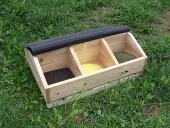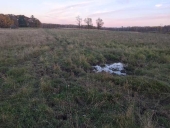Hello new Permie!
I too live on exactly 120 acres, a mix of pasture and woods.
As already mentioned, Walter Jeffries is a great resource (Sugar Mountain Farm), check out his blog.
Additionally, Grant Schultz is raising Kune Kune pigs on his farm, Versaland, on primarily hay, forage, wild meats, etc. Worth exploring his videos as well.
The amount of land needed to truly sustain a domestic hog in a wild setting is a lot. You'd probably raise just a few on your entire 120 acres, and they'd do a lot of potential damage unless you managed them quite intensively.
The hogs will require more lysine in their diet than they will likely find. This is why Walter Jeffries supplements with Whey from a local dairy.
Additionally, the hogs will take a lot longer to reach slaughter weight.
I cannot yet manage my hogs over my entire 120 acres (due to lack of fencing) so I have to settle with raising them on 1.5-2 acres, in a rotational paddock system. They eat a ton of acorns, grasses, frogs, mice and worms, but I still supplement their feed with local Non-GMO corn/soy.
Until we all have 25-year established systems like Mark Shepard's, it would be wise to consider supplementing with high quality feed and then also growing a lot of feed yourself.
My hogs have been eating squash, pumpkins, beets and potatoes for the last 2 months- all surplus from what I grew in my market garden this year.
Additionally, I have a cluster of Jerusalem Artichokes that they haven't even been introduced to yet.
So, my opinion, if you want to raise the hogs in a decent timeframe 6-8 months, and can't manage them across your entire 120 acres, then build a system something like:
1) Supplement with high quality non-GMO or Organic feed.
2) Rotate the pigs and monitor their rooting so that you don't destroy the soil profile.
3) Grow a much bigger garden than normal and feed them the surplus and use them to "till" the garden for you. They will root out every last piece of remaining vegetation for you.







